Contents
Market Overview
Macro Update
Global markets showed cautious optimism this week, reflecting a delicate balance between encouraging policy signals from the Trump Administration and deeper questions about the sustainability of growth and policy support. Investors responded positively to confidence from U.S. officials on trade negotiations with China, especially after Thursday’s announcement of a new U.S.–UK trade agreement framed by both governments as a “historic” step forward, alongside fresh momentum for fiscal initiatives in Congress.
Equities advanced this week, although the yield on the 10-year Treasury went higher by 15 to 20 bps, settling near 4.35%. Concurrently, the U.S. dollar gained ground, approaching the 101 mark on the DXY – its highest level since geopolitical dislocations began earlier this year. The euro, despite pulling back toward 1.12 against the dollar, remains close to its one-year highs. Commodities, too, reflected this fragile optimism: Brent oil managed to remain anchored above $60 per barrel. Gold gave back earlier gains, finishing flat as demand for traditional safe havens softened.
As widely anticipated, the FOMC opted to hold its policy rate steady at 4.25–4.50%, and it was Chair Jerome Powell’s messaging that drew the most attention. While acknowledging that “economic risks have risen”, Powell reiterated the Fed’s belief that the U.S. economy remains resilient enough to justify a patient, data-dependent approach. This message, which carried shades of stagflationary concern – highlighting risks of both elevated inflation and rising unemployment – nonetheless leaned heavily on the absence of firm evidence in the hard data.
Macro data offered a mixed bag this week. The ISM services index rose more than expected to 51.6, pointing to an uptick in domestic demand – possibly frontloaded by tariff fears. Meanwhile, the March trade deficit widened sharply to -$140.5 billion, its largest monthly gap in over a decade. Consumer borrowing also rose significantly, led by increases in credit card and auto-related lending, reflecting both resilient consumption and potentially higher financial strain. Jobless claims remained broadly stable at 228,000, although labor market commentary pointed to layoffs in transportation, hospitality, and the public sector – developments worth monitoring for signs of softening.
Across the Atlantic, political and economic signals were similarly complex. Friedrich Merz’s confirmation as German Chancellor required an unprecedented second-round vote, an early signal of the fragile parliamentary coalitions now shaping European governance. Meanwhile, far-right populist candidate George Simion emerged as the front-runner in Romania’s rerun presidential election, reflecting broader regional trends of political volatility.
European economic data, by contrast, offered modest upside surprises. German factory orders and industrial production significantly outpaced expectations, pointing to renewed momentum in Europe’s largest economy. These positive signals, however, are tempered by ongoing concerns over trade tensions with the U.S.
The Bank of England delivered a 25 bps rate cut to 4.25%, though the internal vote revealed deep divisions. Two members favored a larger cut, while two opted to hold -highlighting the policy uncertainty confronting many central banks as they weigh still-elevated inflation against rising signs of demand fragility.
In Asia, regional currencies, particularly the Taiwanese dollar, appreciated rapidly against the greenback, driven by exporter-led dollar selling and shifting domestic flows. Geopolitical risks re-emerged, with India launching airstrikes into Pakistani territory – an escalation that reignited fears of broader conflict in a nuclear-armed region. Both the U.S. and China urged restraint.
China’s latest data pointed to decelerating momentum in services, with the Caixin services PMI slipping to 50.7. In response, the Central Bank stepped in with measured monetary easing, including a 10 bps cut to the reverse repo rate and a 50 bps reduction in reserve requirements, intended to inject around 1 trillion yuan into the system. While supportive, these measures also reflect the mounting policy burden in an environment where cyclical headwinds are increasingly intertwined with structural challenges.
April trade data were better than expected. Export data illustrated how China’s economy is responding to new U.S. tariffs. Its exports grew 8.1% year-over-year despite a 21% year-over-year drop in exports to the U.S. The growth was driven by reroutes largely to Southeast Asia markets. Imports contracted by a moderate 0.2% year-over-year compared to consensus expectations of -6.0% year-over-year, keeping the trade balance elevated for the month.
EM Credit Update
EM hard currency sovereign debt returned +0.3%, driven by the high yield segment which recovered this week, returning +0.7% as risk sentiment became more positive. In comparison, the return for EM investment grade sovereigns was slightly negative (- 0.1%). Sovereign spreads tightened by 12 bps overall, driven by a 21 bps tightening in high yield versus only -5 bps for investment grade.
Latin America and Africa drove sovereign returns again this week, with high beta credits like Venezuela, Ecuador, Ghana, and Senegal outperforming. Romania was the top underperformer this week due to political instability, fiscal reform concerns, and market unease over the rise of euro-skeptic George Simion as the presidential front-runner.
EM local currency sovereign performance turned slightly negative this week (-0.2%) as dollar weakness abated. Romania was the key underperformer in local currency as well.
EM corporates lagged sovereigns slightly this week, delivering a return of +0.1% at the index level, driven by a return of +0.2% for the high yield segment versus a flat return for investment grade. Corporate spread moves were also muted, with overall spreads tighter by 6 bps and not much differentiation between investment grade and high yield.
Primary market activity continued to be busy in the corporate space this week with nine corporate issuers tapping the market. There was no new sovereign issuance this week.
The Week Ahead
Markets face a confluence of geopolitical and economic catalysts next week, with a focus on U.S.-China trade talks in Switzerland. Investors will look for signs of tangible de-escalation. Meanwhile, President Trump’s Middle East tour will have implications for energy markets and geopolitical risk.
In the U.S., a slate of data, including inflation, retail sales, industrial production, and consumer sentiment, will offer a timely read on how tariff dynamics are translating into real economic outcomes. Corporate earnings, particularly from consumer bellwethers like Walmart, will complement this macro view, while remarks from Fed Chair Powell and other Fed governors could refine markets’ understanding of the Central Bank’s reaction function amid the evolving economic backdrop.
Across the Atlantic, European finance ministers gather in Brussels as the region digests fresh GDP and industrial production data, with the ZEW survey expected to shed light on forward-looking sentiment. The UK’s first-quarter GDP and industrial output will also be released.
In Asia, Japan will publish Q1 growth and industrial production figures, while China’s April CPI and PPI are anticipated to confirm ongoing deflationary pressures despite an expected pick-up in credit growth. Meanwhile, the Philippines heads into midterm elections, with expectations for President Ferdinand “Bongbong” Marcos Jr. to retain legislative control.
Elsewhere in emerging markets, Banxico is widely expected to cut its policy rate by 50 bps, while Türkiye’s current account release will shed light on its latest external account dynamics.
Fixed Income
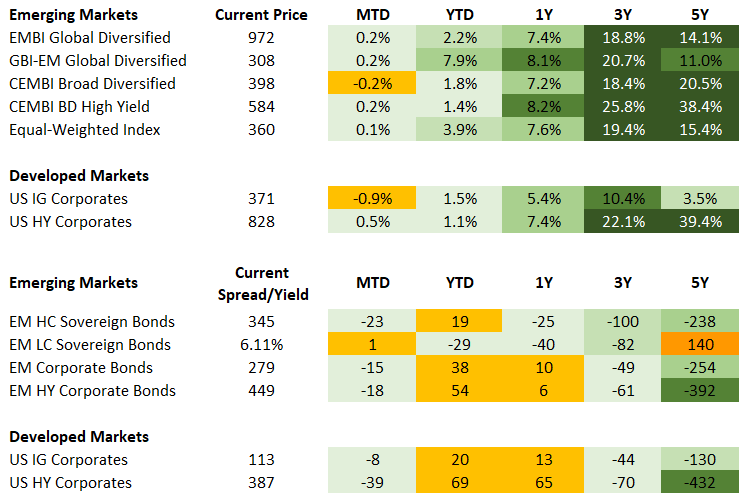
Equities
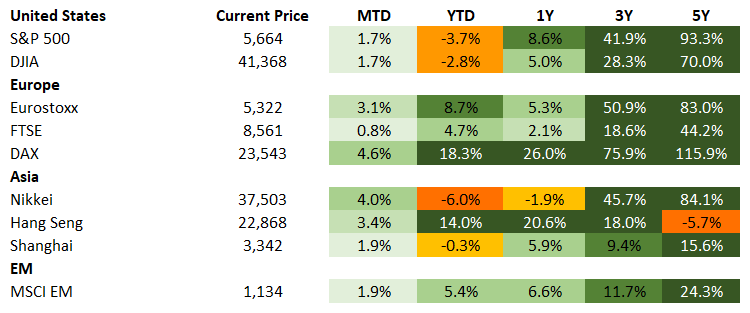
Commodities

Source for data tables: Bloomberg, JPMorgan, Gramercy. EM Fixed Income is represented by the following JPMorgan Indicies: EMBI Global, GBI-EM Global Diversified, CEMBI Broad Diversified and CEMBI Broad High Yield. DM Fixed Income is represented by the JPMorgan JULI Total Return Index and Domestic High Yield Index. Fixed Income, Equity and Commodity data is as of May 9, 2025 (mid-day).
Highlights
Legislative Majority for Noboa Would Mark Credit Improvement for Ecuador
Event: Sources close to Ecuador’s market-friendly President Daniel Noboa, re-elected last month in a landslide victory against populist challenger Luisa Gonzalez, announced this week a “great accord” with the country’s indigenous movement Pachakutik that gives the government a working majority in the National Assembly. Pachakutik denied a formal agreement had been reached, but negotiations appear to be ongoing ahead of the assembly’s swearing-in on May 14th.
Gramercy Comment: Ecuador’s National Assembly has a history of high fragmentation, which has historically complicated economic policy and reform implementation by the executive branch. As such, a working legislative majority for President Noboa would be a structural departure from the recent past and mark a material credit-positive development, from our perspective. Reaching and maintaining a political alliance with left-wing Pachakutik would be challenging for the center-right Noboa Administration and would require certain political concessions. But even if a formal alliance does not materialize, the government has other options, including poaching some of the nine Pachakutik and/or 67 Correista lawmakers in the 151-seat National Assembly. Our view is that one way or another, President Noboa has a good chance to construct a working majority when he starts his new term on May 24th. This will be important for maintaining economic reform momentum under Ecuador’s excellent relationship with the IMF, but probably even more so in terms of avoiding a return of political uncertainty.
With a legislative majority, President Noboa likely faces significantly diminished political incentives to seek a Constituent Assembly to change the constitution and introduce reforms, which is seen as risky from a market perspective and as a credit negative.
Romania’s Political Uncertainty Poses Fiscal and Rating Risks
Event: Romania held the first round of its presidential rerun election on May 4th, following cancellation of the original vote in late 2024 on foreign interference. George Simion, a far-right populist candidate of Alliance for the Union of Romanians (AUR), secured first place with 41% of the votes. Mr. Simion will face independent candidate Nicusor Dan, who received 21% support, in a run-off vote on May 18th. The ruling coalition candidate, Crin Antonescu, received 20% backing and will not proceed to the second-round. Antonescu’s loss triggered Prime Minister Marcel Ciolacu’s resignation and appointment of National Liberal Party (PNL) leader Catalin Predoiu as a 45-day caretaker Prime Minister. Romania’s local and hard currency bonds sold off in the aftermath.
Gramercy Comment: The election outcome elevates political uncertainty, and risks further delay in much-needed fiscal consolidation, uncertainty over EU funds, and ratings downgrades to high yield. Romania’s large twin deficits have been financed with chunky international and domestic issuance, as well as EU funds, in recent years. In the event of Mr. Simion’s win, the risk of a snap election is high because he has stated he may appoint previously barred Calin Georgescu as Prime Minister, who likely wouldn’t receive backing from establishment parties. This would, at a minimum, limit the government’s ability to quickly push forward fiscal reform and likely trigger at least one rating downgrade by September. Mr. Simion’s anti-EU and NATO stance, as well as skepticism over Ukraine support, also could complicate broader EU dynamics at a critical juncture.
Under the more moderate Mr. Dan, there would be scope for swifter action on fiscal policy and less acute risks to EU funds and relations, but rating downgrades are still possible, depending on coalition dynamics and policy execution.
Emerging Markets Technicals
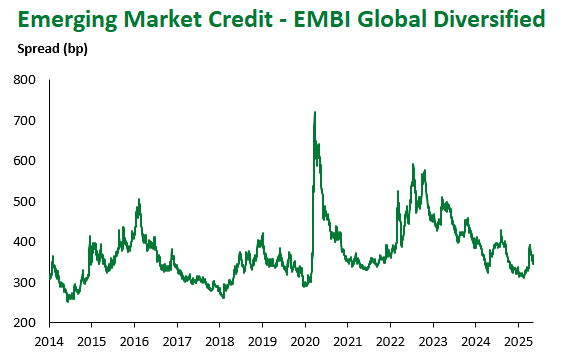
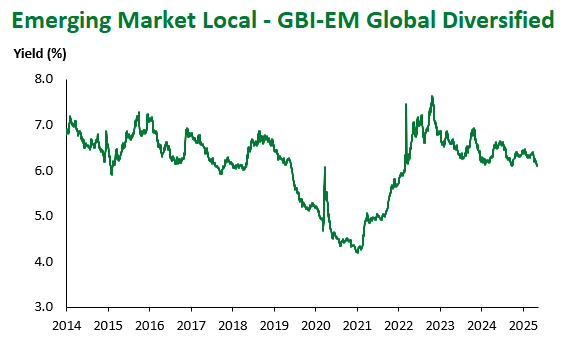
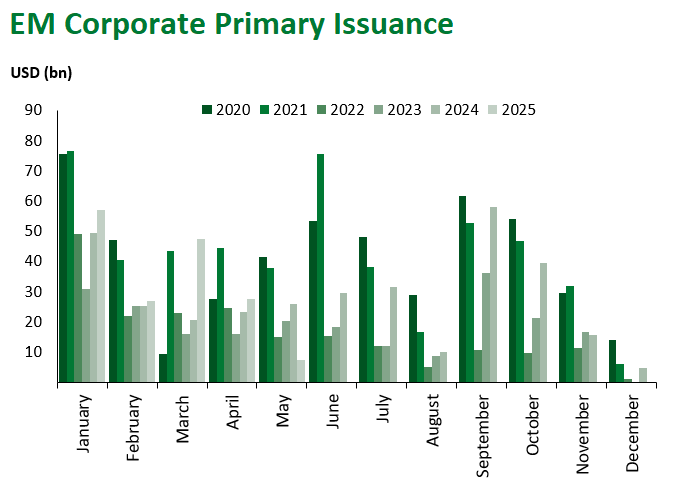
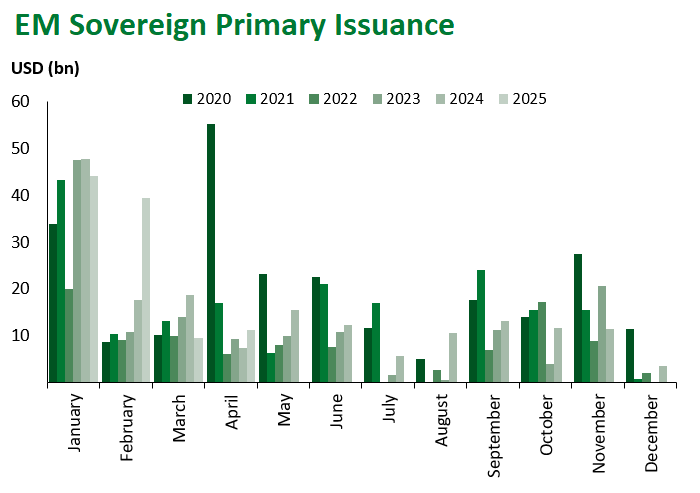
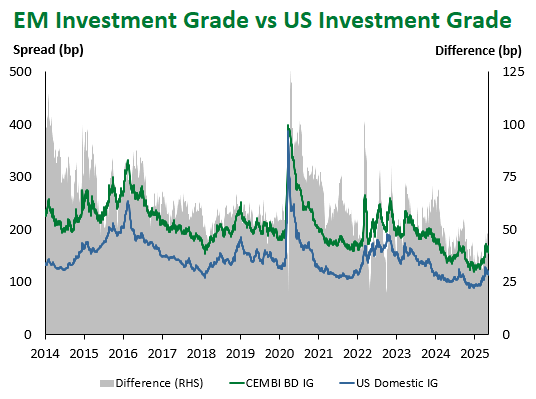
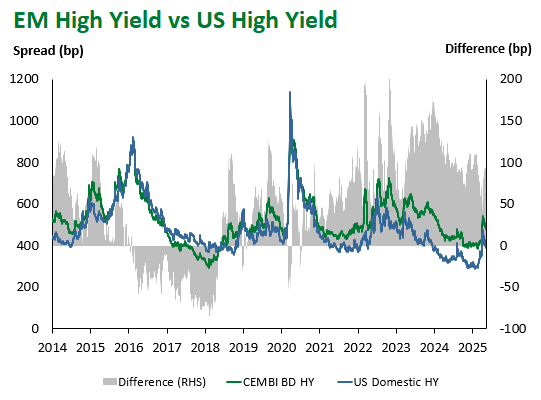
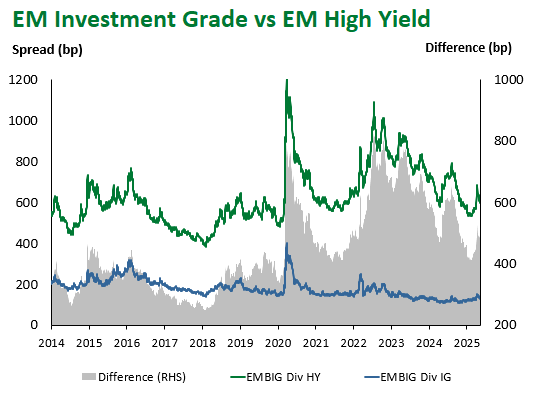
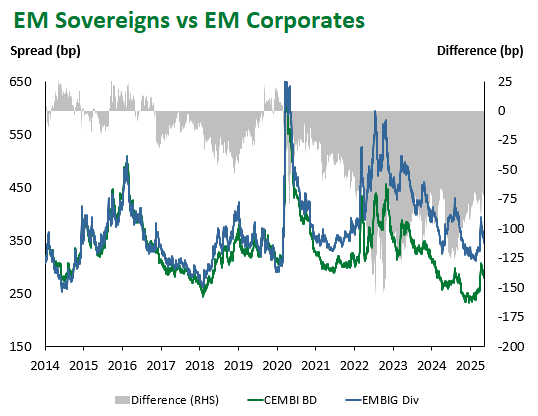
Emerging Markets Flows
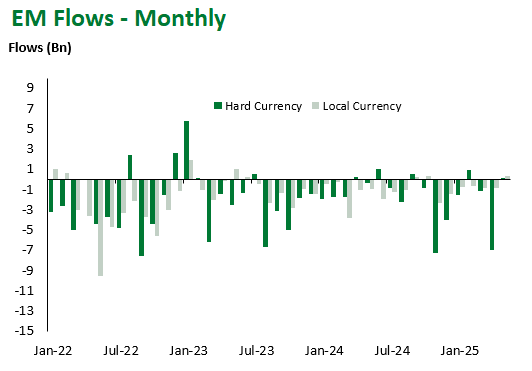
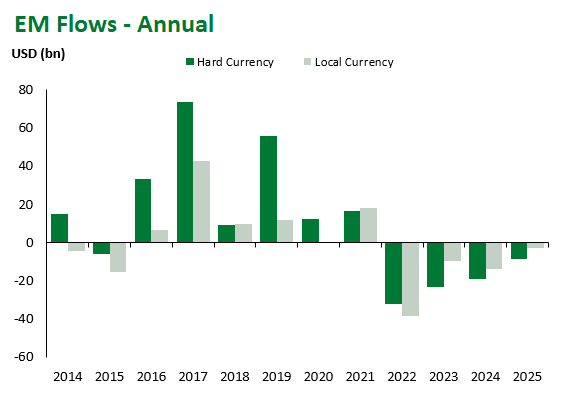
Source for graphs: Bloomberg, JPMorgan, Gramercy. As of May 9, 2025.
For questions, please contact:
Kathryn Exum, CFA ESG, Director, Co-Head of Sovereign Research, [email protected]
Petar Atanasov, Director, Co-Head of Sovereign Research, [email protected]
This document is for informational purposes only. The information presented is not intended to be relied upon as a forecast, research or investment advice, and is not a recommendation, offer or solicitation to buy or sell any securities or to adopt any investment strategy. Gramercy may have current investment positions in the securities or sovereigns mentioned above. The information and opinions contained in this paper are as of the date of initial publication, derived from proprietary and nonproprietary sources deemed by Gramercy to be reliable, are not necessarily all-inclusive and are not guaranteed as to accuracy. This paper may contain “forward-looking” information that is not purely historical in nature. Such information may include, among other things, projections and forecasts. There is no guarantee that any forecasts made will come to pass. Reliance upon information in this paper is at the sole discretion of the reader. You should not rely on this presentation as the basis upon which to make an investment decision. Investment involves risk. There can be no assurance that investment objectives will be achieved. Investors must be prepared to bear the risk of a total loss of their investment. These risks are often heightened for investments in emerging/developing markets or smaller capital markets. International investing involves risks, including risks related to foreign currency, limited liquidity, less government regulation, and the possibility of substantial volatility due to adverse political, economic or other developments. References to any indices are for informational and general comparative purposes only. The performance data of various indices mentioned in this update are updated and released on a periodic basis before finalization. The performance data of various indices presented herein was current as of the date of the presentation. Please refer to data returns of the separate indices if you desire additional or updated information. Indices are unmanaged, and their performance results do not reflect the impact of fees, expenses, or taxes that may be incurred through an investment with Gramercy. Returns for indices assume dividend reinvestment. An investment cannot be made directly in an index. Accordingly, comparing results shown to those of such indices may be of limited use. The information provided herein is neither tax nor legal advice. Investors should speak to their tax professional for specific information regarding their tax situation.
